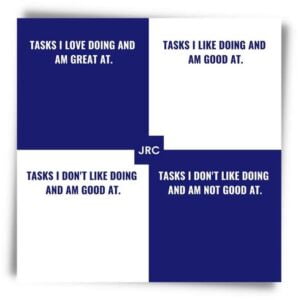HOW CAN ‘DEEP WORK’ GET YOU BACK TO DOING AN EXTRAORDINARY JOB?
Do you want to do your job or do an extraordinary job?
There are times when we run on all cylinders, everything comes together, and we feel like we are at the top of our game. In contrast, there are times when we may feel we have lost our work mojo, are bored, stagnant, and just go through the motions of our job. I know how I prefer to feel, how about you?
A tool to help you regain focus on what you are doing and how you are doing it is to ensure you immediately implement ‘deep work’ time into your schedule. This mode helps you have an uninterrupted focus on a significant task.
Your ‘deep work’ time should be allocated to projects or tasks that require your undivided attention to move forward and will have the greatest impact. This sounds so straightforward and obvious that you may ask why I even need to write about this, so I challenge you to look at your schedule over the past month and honestly evaluate how much time you allocated to ‘deep work.’
When you allocate time in your day where you can work in isolation, without distraction, the quality and quantity of work you can complete can be extraordinary. It takes time, focus and persistence, but it will be worth it.
Reorganize your month ahead to ensure you have time in your schedule daily for ‘deep work.’
Your days maybe spent, rushing from one meeting to another or putting out continual fires – this is fractured work. Fractured work occurs when you are primarily responding to others’ needs and requirements. It is unrealistic to think that you can cut out fractured work in your day-to-day commitments; however very realistic to combine it with periods of uninterrupted focus.
To do extraordinary work, we need periods of concentration and focus.
Determine how much ‘deep work’ time you need daily, schedule it, and make it a non-negotiable priority for the month ahead.
QUESTIONS FOR YOU TO ANSWER:
- How can I schedule my time in September so five days per week, I have at least one hour daily allocated to ‘deep work’?
- Are there any periods in the year that I need more time to focus on ‘deep work’? If so, when? Now go ahead and block off that time in your schedule.
- What will you have to do in your space to ensure it will promote ‘deep work,’ or where else can you go to facilitate ‘deep work’?
EFFECTIVE ONE-ON-ONE MEETINGS WITH DIRECT REPORTS
Having effective one-on-one meetings is a critical leadership skill. I recommend having weekly one-on-one meetings with each of your direct reports. The objective of this meeting is to ensure there is open and transparent communication on priorities, identification of opportunities, issues or challenges and time to address any questions or concerns that may be affecting the progress of your direct report.
To have effective meetings, ensure you have a plan, are organized to optimize your meeting time, have clear outcomes in mind, and record who is responsible for what by when, making it is easier for you to follow up.
The following are an example of questions that you could ask in a one-on-one:
- What were your biggest wins over the last week/since we last met?
- What worked well, what didn’t and why?
- Are there any areas in that I can support you?
- What are your top three priorities for the upcoming week?
- Is there anything else that you would like to cover today?
I encourage you to monitor how much you talk in these meetings. My suggestion is that you should not be speaking for more than 20% of the meeting. Focus on listening, not jumping in and solving problems but asking clarifying questions.
MEETING TIPS
For many, meetings are painful, and I am sure you have felt, heard, or empathize with the following:
‘I have too many meetings.’
‘The meetings are too frequent and too long.’
‘Meetings are a waste of my time.’
‘I hate it when people show up late or don’t contribute – why bother!’
Here are some helpful tips for you:
- Look at the meetings in your schedule over the upcoming week and determine if your attendance is necessary. If it is not, message the organizer with your rationale and withdraw yourself from attendance.
- When scheduling a meeting, ensure that the right people are in attendance and the duration is the correct length (the shorter, the better).
- If you are organizing or chairing a meeting in advance, prepare and circulate an agenda along with any documents that need to be reviewed.
- Follow up on your meeting notes, complete what you said you would and hold others accountable for assigned tasks.
Speak up on annoying behaviours like:
- Individuals being on their phones during the meeting, checking emails, social or surfing
- Arriving late and being disruptive
- Interrupting and talking too much
- Not coming prepared
- No participating
Each behaviour is a sign of disinterest and disengagement, don’t ignore it. Be focused on acknowledging it and changing the behaviour.
If you have any questions about implementing deep work times in your schedule or want to learn more on the powerful benefits of executive coaching to elevate your professional success, please reach out to +1 604-616-1967 or jenny@jennyreilly.com and book a complimentary 30-minute strategy session. If you want monthly leadership and professional development tips, sign up for my JRC newsletter or check out my social media on Instagram for top leadership advice throughout the year.


